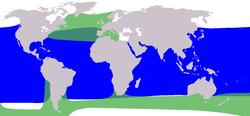Pilot whale
| Pilot Whale | |
|---|---|
 |
|
 |
|
| Size comparison between a short-finned pilot whale and an average human. | |
| Scientific classification | |
| Kingdom: | Animalia |
| Phylum: | Chordata |
| Class: | Mammalia |
| Order: | Cetacea |
| Suborder: | Odontoceti |
| Family: | Delphinidae |
| Genus: | Globicephala |
| Species | |
|
Globicephala macrorhynchus |
|
 |
|
| Green: Long-finned range; Blue: Short-finned. | |
The pilot whale is either of two species of cetacean in the genus Globicephala. The genus is part of the oceanic dolphin family (Delphinidae). The two species are the Long-finned Pilot Whale and the Short-finned Pilot Whale. The two are not readily distinguished at sea. They and other large members of the dolphin family are also known as blackfish.
Contents |
Description

Pilot Whales are jet black or a very dark grey color. The dorsal fin is set forward on the back and sweeps back. The newborn whale's dorsal fin is flexible at birth so as to facilitate the birthing process. The body is elongated but stocky and narrows abruptly toward the tail fin.
Males are less gracile in form than the females. Differences between long and short-finned pilot whales are quite subtle, and where their distributions overlap it is generally not possible to tell the species apart at sea. On land specimens may be distinguished by the length of flipper, the number of teeth and the shape of the skull: the Short-finned has a more bulbous head particularly in older males; the Long-finned is squarer, and the forehead is more likely to overhang the mouth. G. macrorhynchus was described, from skeletal materials only, by John Edward Gray in 1846. He presumed from the skeleton that the whale had a large beak ("macrorhynchus" in Latin).

Birth weight of calves is roughly 220 lb. (100 kg.). Adult males can reach up to 20 feet (6.1 m) and weigh up to 3 tons. Adult females measure up to 16 feet (4.9 m) and weigh up to 1.5 tons.[1] Life span is about 45 years in males and 60 years in females for both species.

Both species live in groups of about 10 to 30 in number on average but some groups may be 100 or more. They are quite active and will frequently lobtail, spyhop and approach boats.
Pilot Whales feed predominantly on squid. As compared to their other tooth-whale relatives they have many fewer teeth; numbering only 30 to 40 as compared to 120 in the bottlenosed dolphin. This is thought to be an adaptation to their squid-eating diet.
Population and distribution
Pilot Whales are amongst the most common and most widely distributed of the marine mammals in the cetacean order.
The Long-finned species prefers slightly cooler waters than the Short-finned and is divided into two populations. The larger group is found in a circumpolar band in the Southern Ocean running from approximately 20° S to 65° S. It may be sighted off the coasts of Chile, Argentina, South Africa, Australia and New Zealand. There are estimated to be in excess of 200,000 individuals in this group. The second population is much smaller and inhabits the North Atlantic Ocean, in a band that runs from South Carolina in the United States across to the Azores and Morocco at its southern edge and from Newfoundland to Greenland, Iceland and northern Norway at its northern. It is also present in the western half of the Mediterranean Sea.
The Short-finned species is more populous. It is found in temperate and tropical waters of the Indian, Atlantic and Pacific Oceans. Its population overlaps slightly with the Long-finned Species in the western Atlantic. There are 150,000 individuals in the eastern tropical Pacific Ocean. There are estimated to be more than 30,000 animals in the western Pacific, off the coast of Japan.
Both species prefer deep water.
Human interaction
The long-term survival prospects of both these species appear positive. Indeed in its Red List of Threatened Species the IUCN lists both the Long-finned and Short-finned as "Lower Risk; conservation dependent".
The Long-finned Pilot Whale has traditionally been hunted by whalers by the process of "driving" – where many fishermen and boats gather in a semicircle behind a pod of whales, that has been sighted close to shore, and slowly drive them towards a bay. When close enough stones attached to lines from the boats are thrown into the water behind the whales, driving them towards the beach where they become stranded and are slaughtered. This practice was common in both the nineteenth and twentieth centuries. Currently only the Faroe Islands operates such a cull. Statistics have been kept for the drives in the Faroe Islands for centuries, and in the 1980s around 1,500 individuals were killed each year in this manner, declining in the 1990s to under a thousand.
The Short-finned Pilot Whale has also been hunted for many centuries, particularly by Japanese whalers. In the mid-1980s the annual Japanese kill was about 2,300 animals. This had decreased to about 400 per year by the 1990s. Killing by harpoon is still relatively common in the Lesser Antilles and Sri Lanka. Due to poor record-keeping it is not known how many kills are made each year, and what effect this has on the local population.
Both species are also collaterally caught and killed in longline and gill-nets each year.
References
- National Audubon Society Guide to Marine Mammals of the World ISBN 0-375-41141-0
- Encyclopedia of Marine Mammals ISBN 0-12-551340-2
- Whales, Dolphins and Porpoises, Mark Carwardine, ISBN 0-7513-2781-6
- ↑ American Cetacean Society Fact Sheet - Pilot Whale
External links
|
||||||||||||||||||||||||||||||||||||||||||||||||||||||||||||||||||||||||||||||||||||||||||||||||||||||||||||||||||||||||||||||||||||||||||||||||||||||||||||||||||||||||||||||